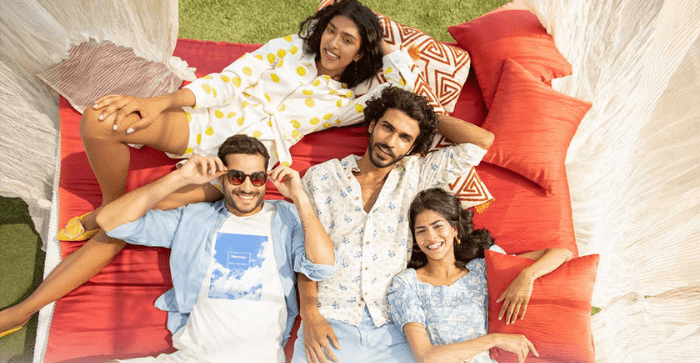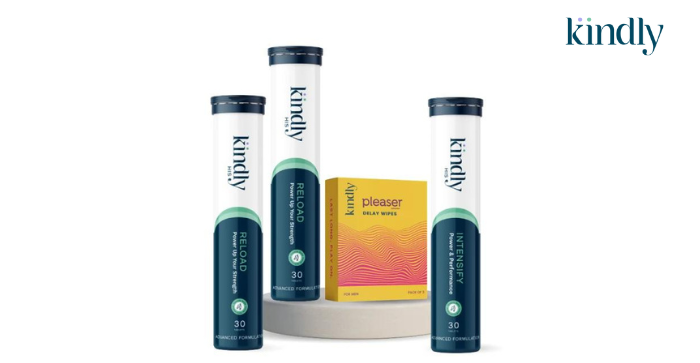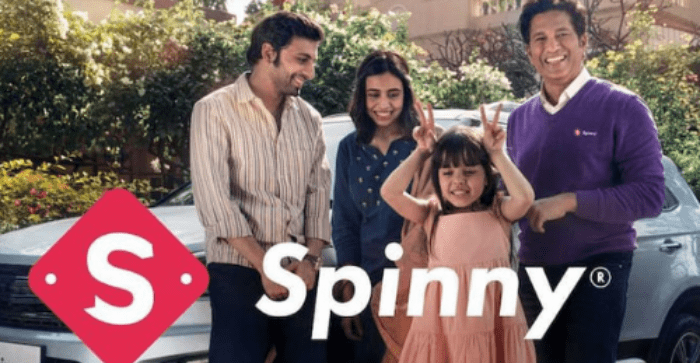AI - Driven Growth Solutions
Ecommerce SEO
A Comprehensive Guide

Infidigit is a CMO’s most preferred partner
2.2B+
Organic Sessions
15M+
Leads Generated
100+
Case Studies
60+
Awards & Recognitions
We are the trusted partners for brands to achieve organic success






































































KNOW ABOUT E-commerce
What is E-Commerce SEO ?
Ecommerce SEO is the process of optimizing an online store to improve its visibility in search engine results. By targeting specific keywords, enhancing website structure, and creating high-quality content, ecommerce SEO helps your products rank higher when potential customers search for them. This includes optimizing product pages, category pages, and even blogs to attract organic traffic.
Ecommerce SEO is the practice of optimizing an online store to improve its visibility and ranking in search engine results pages (SERPs). It focuses on driving organic traffic to your ecommerce website by ensuring that potential customers can find your products and services when they search online. Unlike general SEO, ecommerce SEO is tailored to the unique structure and goals of an online store, with a strong emphasis on product discoverability and conversion optimization.
At its core, ecommerce SEO involves:
- Keyword Optimization: Researching and targeting specific terms your audience uses to search for products.
- Product Page Enhancements: Crafting detailed, compelling product descriptions, optimizing titles, meta tags, and using high-quality images.
- Category Page Optimization: Structuring category pages to make them user-friendly and easily navigable.
- Technical SEO: Improving site speed, mobile responsiveness, and ensuring proper indexing of your pages.
- Content Marketing: Creating valuable content such as blogs, buying guides, and FAQs to attract and retain visitors.
- Link Building: Acquiring high-quality backlinks to boost domain authority and page rankings.
Effective ecommerce SEO not only increases your website’s visibility but also builds trust with potential customers. By aligning your site with what search engines prioritize—relevance, speed, and user experience—you make it easier for shoppers to find exactly what they need while boosting your sales and revenue.
With ecommerce SEO, you’re not just driving traffic; you’re attracting the right audience—people actively searching for your products—making it one of the most cost-effective and sustainable strategies for growing your online business.
Q&A
Unlocking Answers to eCommerce SEO Challenges
"How do I identify the most searched-for keywords when my site has hundreds of diverse products for sale spanning several categories?"
Fun fact – Google’s share of search marketing is a whopping 80%+ in many countries, which means that not only is it the most dominant search engine in the world, but if its mentions of your site are not top-ranking, your site traffic will sag too. It might seem more advantageous to conduct an extensive customer survey, asking them for all the keywords they would use to look for your business. However, doing so can cost you money and time (lots of it)! Besides, it is not always accurate and can lead to errors that could adversely affect your site traffic.
It is next to impossible to categorize and prioritize your keywords manually. Instead, you can use formulas based on sound logic – for instance; you can group and rank your keywords based on key differentiation criteria, such as brand, gender, product group and product sub-group.
For example, Brand = Nike, Adidas, Puma
Product Group = Shoes, Shirts, Saree
Product Sub-group = Casual Shoes, Cotton Shirts, Silk Saree
Then, proceed with creating formulas based on these groups; for example, Brand + Product Sub-group (Nike casual shoes) or Gender + product sub-group (women casual shoes).
Once the list of keywords is ready based on the above formulas that you have selected, it is advisable to run it through Google AdWords keywords planner and get a fair idea of searches that are relevant to that particular keyword. You may want to eliminate all the keywords that have lesser search volume and retain only the ones that you feel are relevant.
"How do I deal with a huge number of dynamic URLs?"
You can also mark them as “non-index, follow,” which would make sure that the link juice is passed on but the pages are not getting indexed. While there are more such options available, we suggest connecting to your SEO team so that they can take up the task of making the optimum utilization of crawl budgets.
"Is there a difference between uppercase and lowercase URLs, and how does each affect my SEO efforts?"
You will be surprised to know that there indeed is a difference between uppercase and lowercase URLs (although it may also depend on the web server you use – Windows OS does not distinguish between them but Linux and UNIX servers do). Simply put, uppercase and lowercase URLs can lead to a fall in your traffic due to the splitting of back-linking references and other factors. Although lowercase URLs are preferred as most people visiting your site would query it that way, you can sidestep this problem of case sensitivity by using the tried-and-trusted method of canonicalization (already discussed) or a 301 redirect (when you redirect all requests to a target URL, saying that the old page has been permanently moved).
"How do I track the performance of my SEO efforts for thousands of keywords?"
Manually tracking all the keywords you are trying to boost site traffic for is an impossible feat. Besides, there are many great tools to help you do this seamlessly, including Advanced Web Ranking and Wherestand, amongst many others. Everything from keyword rankings to competition tracking can be done for any number of keywords; it’s just that simple!
"Why are backlinks so important?"
Backlinks are merely the inbound links or references to your site coming from an external website. Be warned that search engines, in their desire to level the playing field, look for quality mentions of your website on other sites that have relevant or related content. Influencer marketing is your trump card here – scout people who are opinion leaders and can influence a large section of the audience you desire to target. They can post product or service reviews on their blogs or other forums; they include, based on your industry, gadget geeks, trend watchers and fashion designers, nutritionists, etc. Influencer marketing can take the form of paid or unpaid marketing and create instant credibility through tonnes of exposure for your brand.
"How much content can I include on a target page if I want the best possible conversion rate for it?"
Many SEO tenderfoots think that high site traffic is their endgame. Conversion rate, the most coveted metric of them all, is a measure of the degree of the intractability of your webpage with the user. In short, it is to indicate whether you were successful in getting them to do what you want, and in the case of ecommerce sites, it is to buy. Including bulky, keyword-stuffed textual content is certainly not the way to go as it can only do so much for you. Instead, rely on multimedia-rich content that piques the user’s interest. Establishing yourself as the real authority on a subject with quality, popular content on blogs and other content forums will help build and strengthen your brand!
We create success stories like these for your brand
Strategies
Mastering Ecommerce SEO: 24 Proven Strategies
1. Keyword identification
Keyword identification in SEO is a strategic process that helps websites communicate effectively with search engines and, ultimately, their target audience. It begins with understanding the intent behind user searches, aligning chosen keywords with user needs, and evaluating their competitiveness in the online landscape. The relevance of selected keywords to the website’s content is paramount to ensure that visitors find what they’re looking for. Long-tail keywords, which are more specific and target niche audiences, are also a part of the strategy. They may have lower search volumes but can lead to higher conversion rates. Utilizing keyword research tools aids in identifying the most effective keywords, providing insights into search volumes and competition.
A. Long-tail Keywords
Long-tail keywords are longer, more specific phrases that potential customers use during their searches. These keywords often have lower search volume but are highly targeted.
Here are a few examples of long-tail keywords:
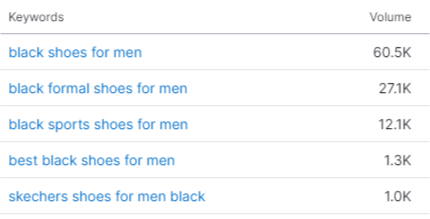
B. Intent Based Keyword
Understanding the intent behind a search is crucial. Are people looking for information? Or are they looking for a specific product or service? Intent-based keywords help you align your content with the user’s goals effectively, ensuring your website resonates with their specific needs.
In Semrush, there are types of keywords like informational, navigational, commercial and transactional. Based on the user intent you can select which type of keyword would work best. Here is a screenshot of the Semrush interface for better understanding.

C. Generic keywords
Generic keywords are broad terms that relate to your industry or niche, and they can be highly competitive. For example, “shoes” is a generic keyword that many businesses vie for in the online marketplace. Where everyone wants to set up shop, making it tougher to stand out.
Here is a screenshot of generic keywords in Semrush. Notice that it also shows you the KD or keyword difficulty, which shows the difficulty level in ranking on SERP.
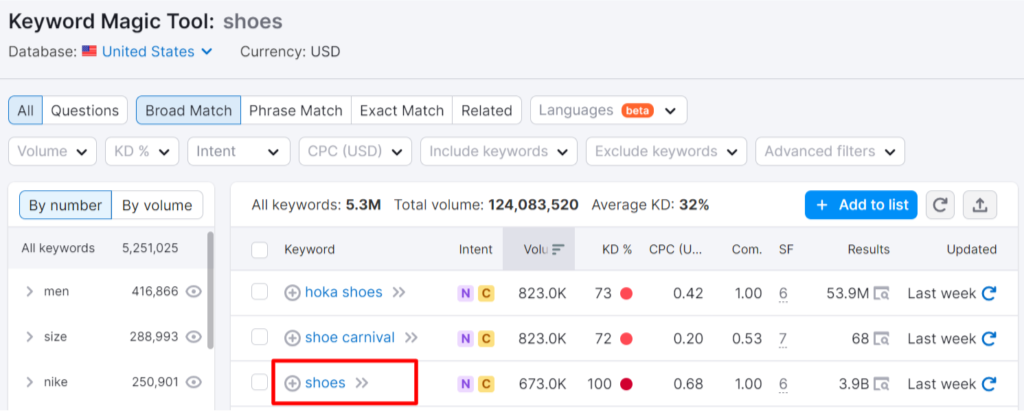
2. Keyword Categorization
Once you have chosen the keyword, you want to focus on the next step which is to analyze the keyword based on factors such, as its category, search volume, and difficulty. This process helps refine your SEO strategy and make it more effective.
To begin with, you can categorize the keyword into tiers typically consisting of primary, secondary and tertiary keywords. Consider these tiers as layers of importance and relevance. The primary keyword represents the topic that you aim to rank for. Secondary keywords provide context and related terms while tertiary keywords are more specific.
Some brands go a step further by categorizing keywords based on their product categories or services. For example, if you are running a clothing store, you could divide your keywords into categories like Mens Clothing, Womens Clothing, Kids Clothing, Sports Apparel, and more. This categorization helps with organization and reporting since it allows tracking the performance of product lines or services.
By categorizing your keywords in this way, you gain an understanding of where to invest your SEO efforts. It ensures that your content remains relevant and aligned with what your target audience i’s searching for. Consequently, this enables you to tune your SEO strategy for impact and establish stronger connections, with potential customers.
Here is an example of categorizing keywords as primary and secondary, as well as dividing based on sub category, search volume and so on.
3. URL Structure Optimization
In URL structure, simplicity is key. An ideal URL should be like a clear road sign that guides both users and search engines through your website. Keeping it simple means avoiding unnecessary jargon, symbols, or convoluted characters that can confuse visitors.
A crucial aspect of URL optimization is incorporating relevant keywords into the URL. Keywords in the URL provide valuable context to both users and search engines about the content of the page. For instance, if you have a web page about “organic gardening tips,” it’s beneficial to include those keywords in the URL, like “www.example.com/organic-gardening-tips.”
Now, here’s where the hyphen (-) comes into play. Using hyphens to separate words in your URL, known as “hyphenation,” is a recommended practice. It enhances readability and helps both users and search engines to understand the structure of your URL. Compare, for instance, “www.example.com/organic-gardening-tips” with “www.example.com/organicgardeningtips.” The former is much easier to read and comprehend.
For better understanding, in the image below, notice how the first URLlooks like a never ending URL. Hence, you have to optimize your URLs as per the image-optimized URL structure.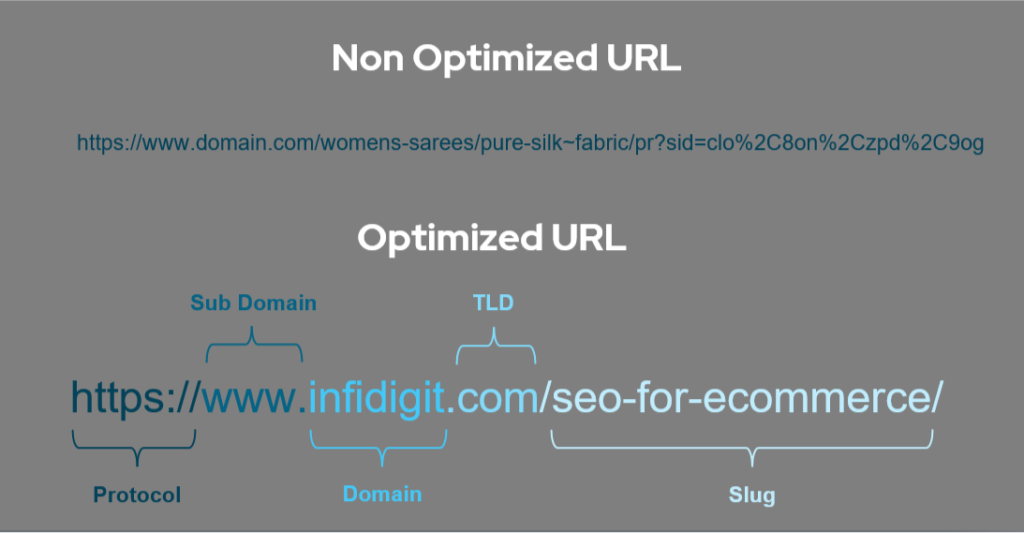
4. Content Strategy
When it comes to online content, quality is king. Crafting valuable content means creating pieces that provide insights and information about your product or topic, offering genuine value to your audience. This content serves as a bridge between your business and your potential customers, helping them understand your products, services, or industry better.
For instance, imagine you are selling a new tech gadget. Instead of just listing its features, you can create comprehensive content that explains how it works, its benefits, and even practical use cases. This not only informs your audience but also showcases your expertise and authority in your niche.
However, creating valuable content is not a one-time effort. The digital landscape evolves rapidly, and user expectations change. That’s why it’s crucial to revisit and update your content regularly. If something feels outdated, it may not resonate with your audience or perform well in search engine rankings.
By keeping your content fresh and up-to-date, you demonstrate your commitment to providing accurate and relevant information. This builds trust with your audience and keeps them coming back for more. Additionally, search engines favor regularly updated content, potentially boosting your website’s visibility in search results.
Creating valuable content is about more than just words on a page; it’s about providing real value and staying current. This approach not only engages your audience but also enhances your online presence and credibility in a rapidly changing digital world.
5. Voice Search Optimization for Product Descriptions
Have you noticed how people have started giving commands to Amazon’s Alexa, Apple’s Siri, Google Assistant, and Microsoft’s Cortana? With smart speakers, wearable devices, and mobile voice assistants becoming extremely popular, voice search has become a powerful tool in your daily lives. It has altered how you make inquiries, perform searches, and shop online.
The growing popularity of voice-enabled devices and virtual assistants has made it crucial for online stores to focus on voice search optimization. It is the process of improving your online visibility to rank better for voice search queries. The goal is to ensure that when users perform a voice search, your website gets selected by or read aloud by voice assistants.
Now, Google also allows users to perform voice searches from desktop devices. However, the results of these voice-based queries are displayed in the same manner as those of text-based queries.
Voice search is different from traditional text-based search. People phrase the queries differently. For example, if you want to find a salon in your vicinity, you will enter the phrase “salon near me” into a search engine. But when you use a voice assistant, you’ll say, “Hey Google, can you find a salon nearby?”
Optimizing product descriptions for voice search is a vital activity of SEO for ecommerce sites. Product titles and descriptions that focus on customer benefits can perform better in voice searches. Thus, you must showcase the product’s benefits and features in simple and concise language that the voice assistant can understand easily.
6. Customer Reviews Display
Positive customer reviews validate the success of your business just as the revenue does. They provide feedback on your efforts and indicate customer satisfaction. Moreover, they aid in marketing your brand to potential customers.
The way you display your customer reviews determines how they will benefit your business and assist with customer acquisition. Thus, you must place them strategically in your ecommerce design. For instance, you can place them on product pages, landing pages, or the homepage to ensure they are most visible and relevant.
You can use different styles and formats to showcase customer reviews. These styles include images, text, videos, or testimonials. Another way you can make the most of your customer reviews is by offering filtering and sorting features. Website visitors can sort reviews by rating, date, or relevance. Lastly, you can add review badges, testimonials, ratings, and other social proof elements to let users understand how reputed and trustworthy you are.
A component of ecommerce SEO focuses on optimizing reviews before they are incorporated into the ecommerce design. You can use schema markup for this. The schema markup code enables search engines to comprehend and display your reviews appropriately in search results. It also suggests relevant keywords and phrases customers must add to their reviews.
Keep in mind that you mustn’t have any fake or duplicate reviews on your website, as they can damage your SEO and credibility. Besides, keep refreshing and updating your reviews to present the latest to your users. It helps in improving user experience and your SEO.

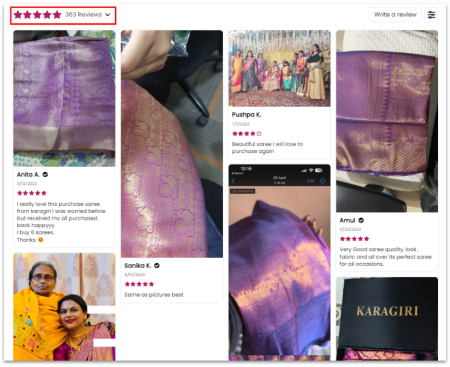
7. Visual Search Integration
In the ever-evolving landscape of Ecommerce SEO, Visual Search Integration is emerging as a game-changing trend. This innovative technology allows users to search for products not through text but by uploading images or using pictures as search queries. It’s like having a personal shopper who understands your style based on the images you provide.
Visual search is particularly valuable in the fashion and home decor sectors, where aesthetics play a significant role in purchasing decisions. Let’s say a shopper sees a stylish outfit or a chic piece of furniture in a magazine or on social media. Instead of struggling to describe it in a text search, they can simply upload a picture and find similar items.
For Ecommerce businesses, this presents a golden opportunity. By integrating Visual Search into your website, you tap into a new dimension of customer engagement. It’s not just about improving user experience; it’s about staying ahead in the competitive ecommerce landscape.
To make Visual Search work for your site, you’ll need to implement image recognition technology and ensure your product images are well-optimized. This includes providing clear, high-quality images and adding descriptive alt text and tags to help search engines understand your visual content.
By embracing Visual Search Integration, you’re not only simplifying the search process for users but also enhancing your Ecommerce SEO strategy. It’s a win-win: customers find what they want more easily, and your business gains a competitive edge in the dynamic world of online retail.
A. Images
In the screenshot below, notice the different product visuals.

B. Video Integration
Video Integration in ecommerce involves seamlessly incorporating video content into your website. It enhances user engagement by providing informative and visually appealing product demonstrations, reviews, and tutorials, making the online shopping experience more interactive and engaging for customers.
In the screenshot below, we show examples of video integration.
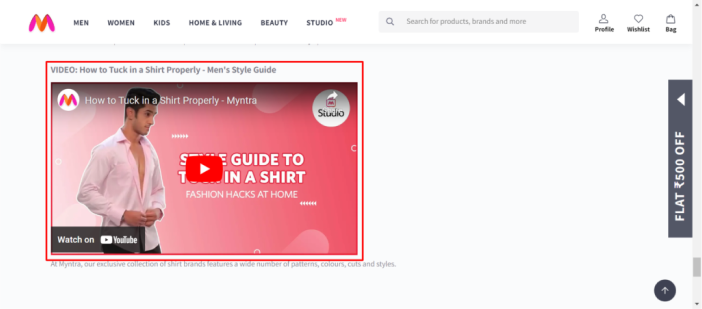
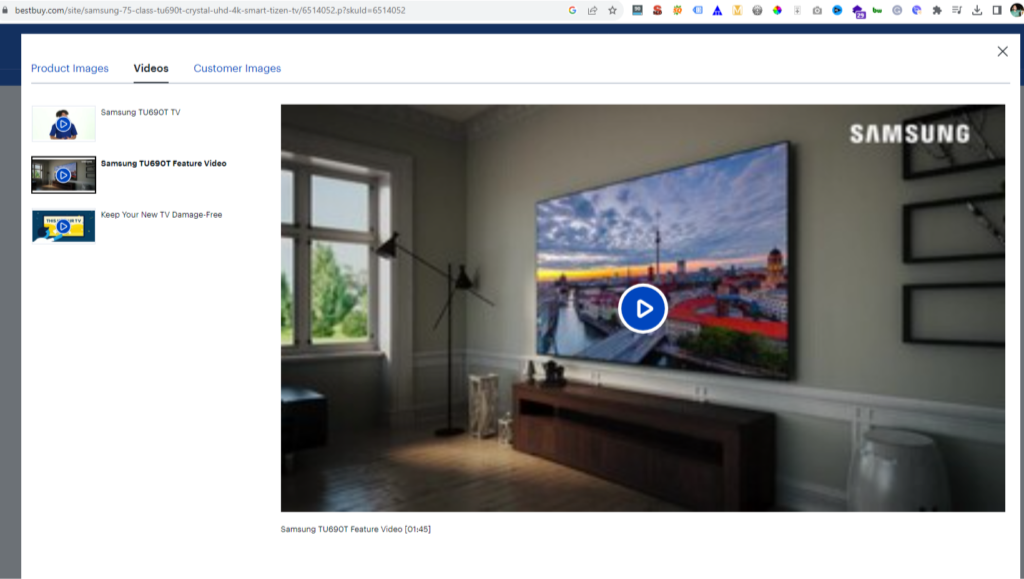
C. Infographics
Infographics are visual representations of information or data, typically combining text, images, and graphics. In ecommerce, infographics enhance content by presenting complex information in a clear, engaging, and easy-to-understand format, making it a valuable tool for educating customers and improving overall user engagement on a website.
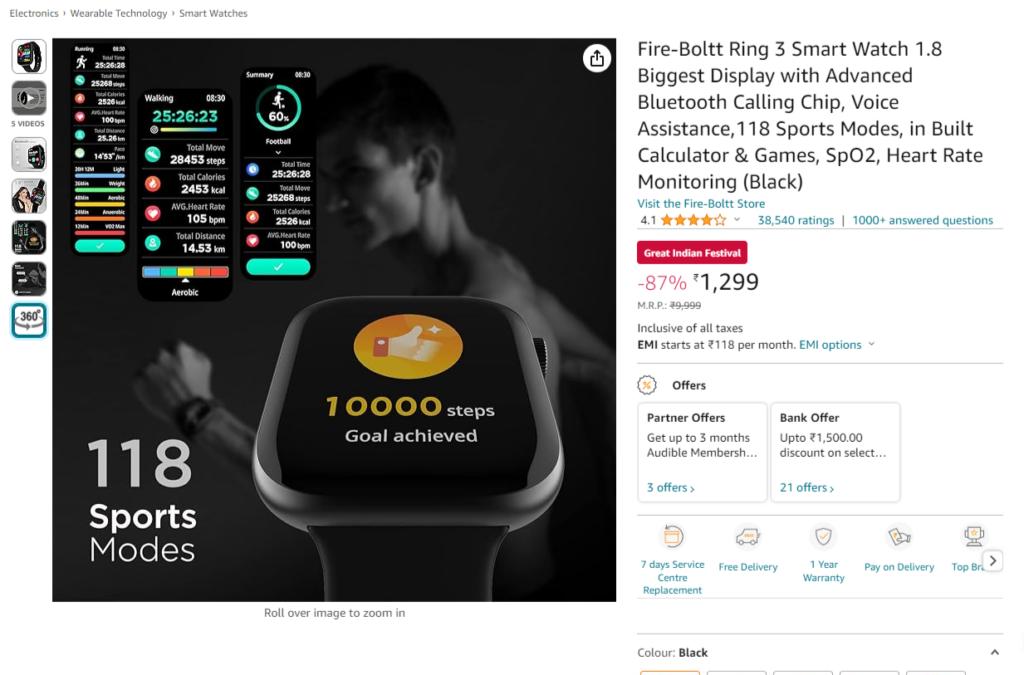
8. Page Gap Analysis
Page Gap Analysis goes beyond traditional keyword research. It’s like detective work for your ecommerce site. You’re not just looking for keywords; you’re investigating what your competitors are doing right.
First, identify your competitors in the ecommerce space. Then, delve into their websites and examine which keywords they are ranking for, which you may not be. These are the “gaps” in your strategy, representing untapped potential.
Once you’ve pinpointed these gaps, you can take action. Create new content that targets these keywords or optimize existing pages to better align with what users are searching for. This proactive approach not only boosts your search engine rankings but also enhances user experience, as your content becomes more aligned with customer intent.
Page Gap Analysis is like finding hidden treasures in the digital landscape, revealing opportunities to capture a larger share of the market and ultimately drive more traffic and conversions to your ecommerce site.
9. Programmatic SEO Automation
Programmatic SEO Automation is like having an assistant that can effortlessly generate web pages optimized for SEO with just a few clicks. This innovative approach streamlines the process of creating web pages with formats, making things incredibly efficient.
Imagine a situation where your website covers cities. With automation, you can easily create pages customized for each city in one click. This means that if you have set up your business in several locations or branches, you can effortlessly replicate pages with the design ensuring a cohesive look across your site.
Moreover, this advanced automation doesn’t stop at page creation alone. It also handles SEO tasks such as optimizing tags, inserting keywords, and even updating content. Not only does it save time but it also guarantees that your website is well-optimized for search engines, enhancing its visibility and rankings.
In summary, Programmatic SEO Automation is a game changer in ecommerce SEO. It enables businesses to efficiently expand their presence while maintaining consistency and minimizing efforts. It represents the future of ecommerce SEO where intelligent technology takes the lead in optimizing websites, for visibility and user experience.
10. Competitor Analysis
Competitor Analysis is the compass that guides your ecommerce SEO journey. It involves a systematic examination of your rivals in the online marketplace. By studying their strategies, strengths, and weaknesses, you gain valuable insights to inform and refine your own SEO efforts.
To begin, identify your top competitors in the ecommerce arena. Scrutinize their websites, content, and keyword strategies. Take note of what keywords they are ranking for, what backlinks they’ve acquired, and how they structure their product pages.
This analysis provides a treasure trove of actionable information. You can discover keyword opportunities you might have missed, understand which content resonates with your shared audience, and even uncover gaps in their strategies that you can exploit.
Competitor Analysis isn’t about copying; it’s about adapting and innovating. Armed with these insights, you can refine your SEO strategy, create more targeted content, and ultimately position your ecommerce business for greater success. It’s like learning from the best in the field to secure your spot at the top.
11. Keyword Density Techniques
Keyword density techniques are like the fine-tuning knobs on your SEO strategy. They involve optimizing the use of keywords within your web content to improve search engine visibility and rankings.
Keyword density refers to the percentage of times a specific keyword or keyphrase appears in your content compared to the total number of words. Striking the right balance is essential. Overstuffing with keywords can lead to penalties from search engines, while underutilizing them may result in missed SEO opportunities.
To gauge keyword density, there are helpful techniques. One method is to use the “cache:” feature along with Ctrl+F in your web browser. Enter your desired keyword, and it will highlight instances of the keyword on the page.
For effective ecommerce SEO, primary keywords should ideally make up around 1.5% to 2% of the total content, maintaining a natural flow. Secondary keywords, if used, can fall in the range of 2.5% to 3%.
These techniques help ensure that your content remains optimized for search engines while remaining user-friendly. By finding the right keyword balance, you can enhance your ecommerce site’s visibility, attract more qualified traffic, and improve your chances of converting visitors into customers. It’s like the art of weaving keywords seamlessly into your content tapestry for maximum impact.
12. Crafting Effective Meta Titles and Descriptions
Meta titles and descriptions are like the welcoming signs to your ecommerce store in the vast online landscape. They are short but powerful snippets of text that appear in SERPs and play a crucial role in attracting potential customers.
The “Meta Title” is the clickable headline that appears as the main title in search results. It should be concise, keyword-rich, and compelling, giving users a clear idea of what your page offers. Think of it as the headline of a newspaper article, grabbing attention instantly.
The “Meta Description” is a brief summary that follows the title in search results. It provides additional context about the page’s content and why users should click through. Crafting an engaging Meta Description is like writing the teaser for a movie trailer; it should pique curiosity and entice users to learn more.
In Ecommerce, optimizing meta titles and descriptions involves using relevant keywords, highlighting unique selling points, and ensuring a clear call to action. Well-optimized Meta Tags not only improve your website’s click-through rate but also enhance your overall SEO strategy by providing search engines with valuable information about your pages.
In essence, meta titles and descriptions are your first opportunity to make a positive impression on potential customers. By making them informative, appealing, and keyword-rich, you can significantly impact your ecommerce site’s visibility and click-through rates, ultimately driving more traffic and conversions.
The meta tags are important because they get displayed on the SERPs; more attractive meta tags will get more traffic/CTR.
13. Header Tags: Key to Structured Content
Header tags are vital to search engines and your users. They send a strong signal for ecommerce SEO and influence search engine rankings. However, they are often one of the most underutilized on-page SEO elements.
If you want to impress the search engine gods and make an impact on your customers, you must use header tags wisely. Search engines do not find websites relevant if they don’t have proper header tags, and visitors are also unlikely to find such sites.
Header tags are of six types, starting from h1 to h6. The h1 tag holds the most importance, while the h6 tag is the least important. These tags are important for ecommerce sites. They make the content more user-friendly since users don’t want to read large chunks of text together.
When the product description is broken into headings and subheadings, the user can find essential details and remain connected for longer. Similarly, search algorithms can also understand your page better and place it higher in search results.
Header tags also make it easier for you to organize information into different headers based on importance. For instance, you can use the h1 tag to highlight the category page and the h2 tag for the listed product titles. Similarly, on the product page, you can use the h1 tag for the product name and h2 to create headings for the product description. The next tag can be used to display information like price, size, color, etc.
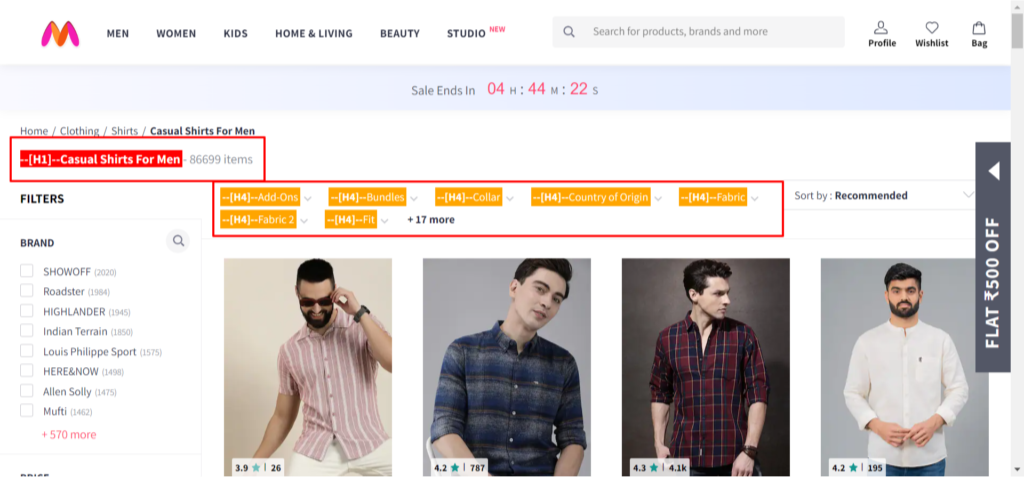
14. Robots.txt
“Robots.txt” is like a gatekeeper for your Eommerce website. It’s a text file placed in the root directory that tells search engine robots which parts of your site they can and can’t access. Think of it as a roadmap for search engines, directing them to crawl and index the essential pages while avoiding sections like private or duplicate content. By configuring Robots.txt correctly, you ensure that your site’s valuable content gets the spotlight in search results, improving SEO and user experience. However, it’s essential to use Robots.txt carefully to avoid unintentional blockages and ensure optimal search engine visibility for your Ecommerce store.
In the snapshot below, you can see how “Robots.txt” is optimized. It clearly explains to search engine crawlers which URLs they are allowed to access on your site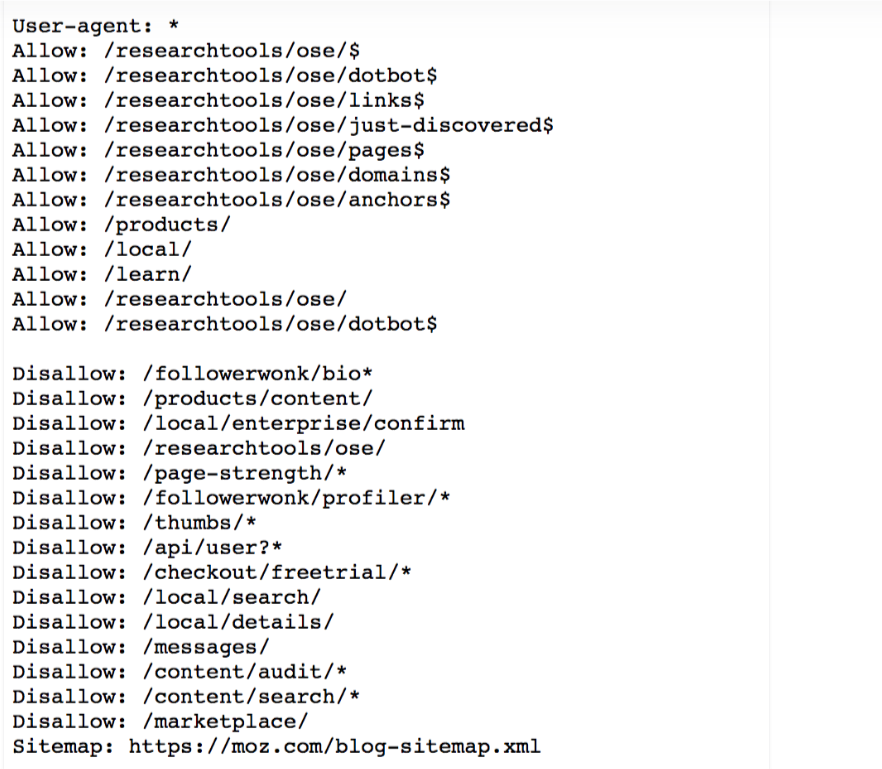
15. Sitemap
A “Sitemap” is like the index of a book for search engines. It’s a file or page on your Ecommerce website that lists all the URLs you want search engines to crawl and index. This organized roadmap helps search engines discover and understand your site’s structure and content, ensuring that all your important pages get the attention they deserve in search results. By providing a Sitemap, you enhance your Ecommerce SEO strategy, making it easier for search engines to rank your pages and improving your site’s overall visibility and performance in search engine rankings.
There are two types of sitemap:
An HTML Sitemap is for the users. It helps visitors navigate across the website easily. The following is a screenshot of an HTML Sitemap:
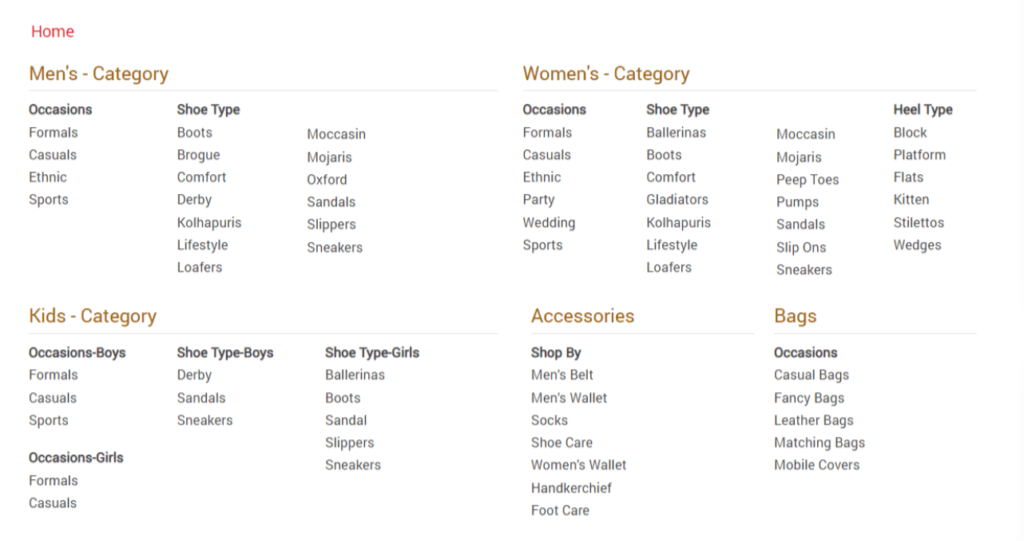
An XML Sitemap, on the other hand,helps bots to crawl the website more efficiently. It also helps them understand which are the most important URLs on a site.
The following is a screenshot of an XML Sitemap:
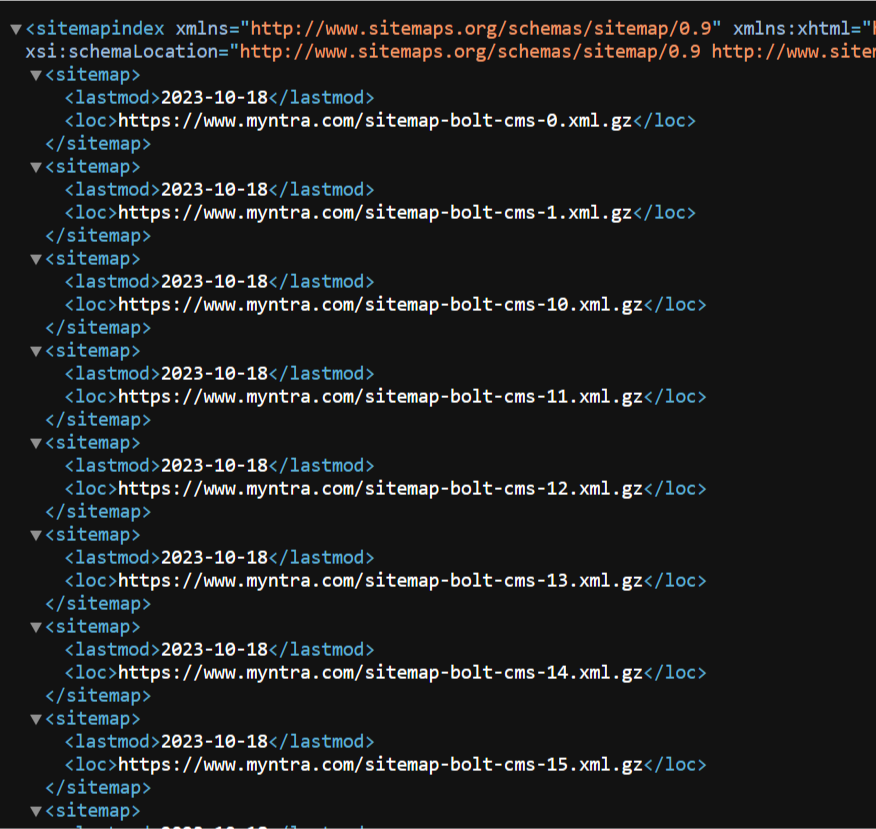
16. Canonical tags
17. Website Speed
Website Speed is the highway on which your Ecommerce store operates. It refers to how quickly your website’s pages load and respond to user interactions. Just like a fast car, a speedy website offers a smoother and more enjoyable ride for its visitors. In the world of Ecommerce SEO, website speed plays a pivotal role. Search engines, like Google, prioritize fast-loading websites because they provide a better user experience. Slow-loading pages can frustrate users and lead to higher bounce rates, negatively impacting your SEO rankings. Optimizing website speed involves various strategies, such as minimizing image sizes, optimizing code, and leveraging content delivery networks (CDNs). These efforts ensure that your ecommerce site loads swiftly across devices and browsers. A faster website not only pleases users but also improves your SEO rankings, potentially leading to higher organic traffic and increased conversions. In the competitive landscape of online retail, having a speedy website is akin to having a well-tuned racing car—it can propel your ecommerce business ahead of the competition. The tool page speed insights give you a clear picture of the webpage speed and all the issues related to Performance, Accessibility, Best Practices, and SEO. The snapshot below is taken from https://pagespeed.web.dev/
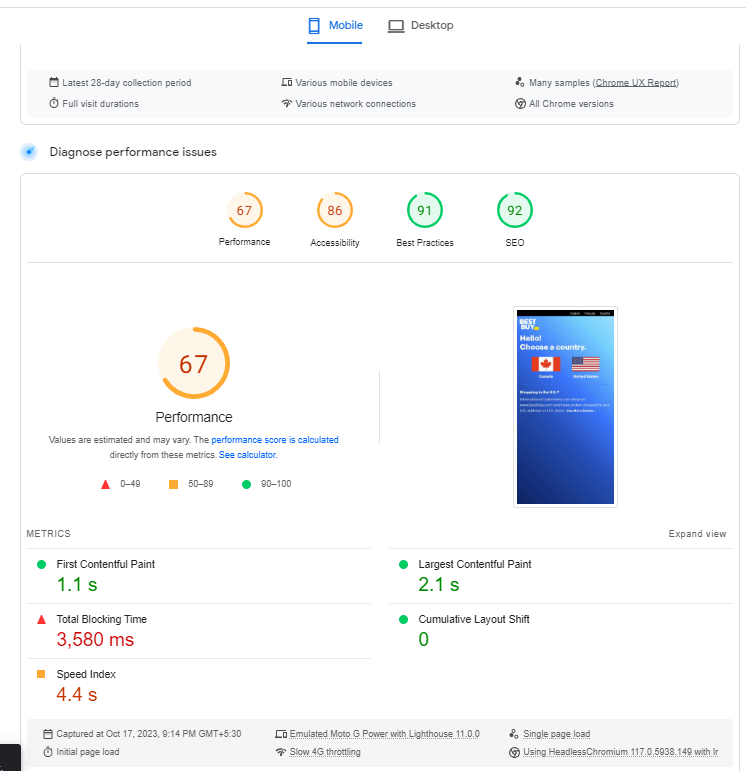
18. Site Structure
Site structure is like the blueprint of your website, outlining how its pages, content, and navigation are organized. It’s a critical component that impacts both user experience and SEO. A well-structured site makes it easier for visitors to find what they need, enhancing user satisfaction. At the same time, search engines appreciate a clear site structure as it helps them crawl and index your pages more efficiently. Think of it as the foundation that supports your online presence, ensuring a smooth journey for both users and search engines on your website.
In the snapshot below, there are pages and posts of a website. These often have a variety of – related – topics, and site structure deals with how this content is grouped, linked and presented to the visitor. In other words, the site structure is where all the categories are visible and easy to hover on that particular page
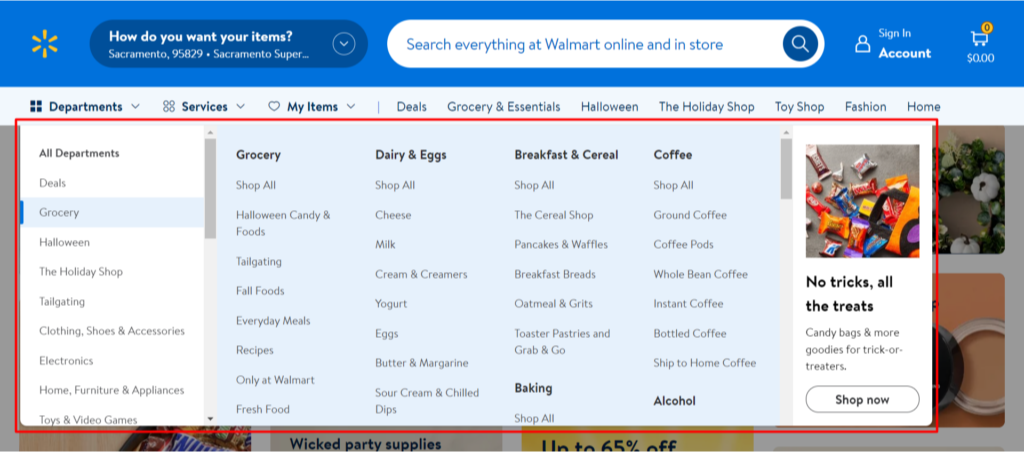
19. Pagination
Pagination defines how your website tackles a block of content or product list that cannot fit comfortably on the user’s screen. For instance, if your ecommerce site offers 300 different products under one category, pagination allows you to segregate these products into smaller chunks and display 30 items each on 10 pages.
Pagination appears to be an easy solution to manage large chunks of data. However, if you have not implemented it strategically, it impacts the search engine rankings and authority of those pages. On the other hand, a correctly implemented pagination system allows search engines to crawl and index pages and their content much faster.
Additionally, appropriately configured pagination enables users to navigate the website smoothly. This is especially true for ecommerce stores offering a wide variety of products under one category.
There are different ways to optimize pagination pages. The first is to build a unique URL. Every page, apart from the first page, should have a distinct parameter in its URL to denote its position in the list of pages.
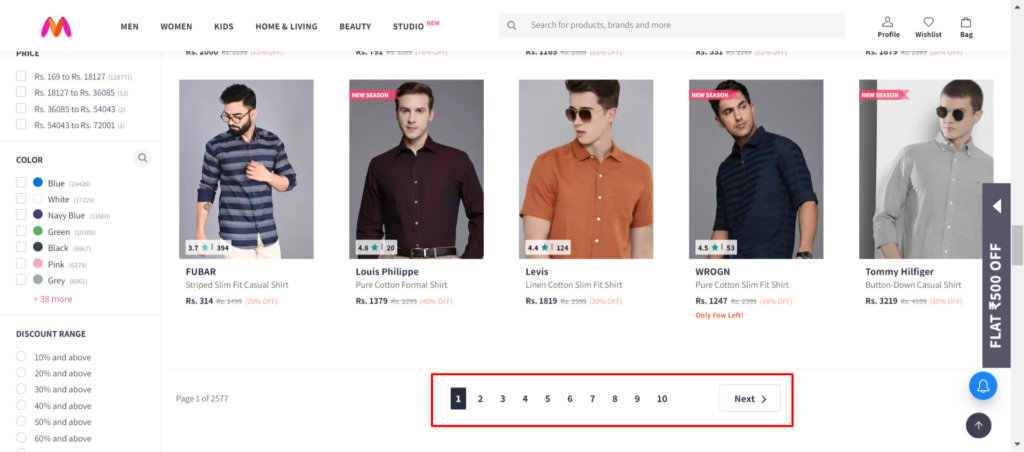
20. Keywords Ranking
Keywords ranking is like the scoreboard for your ecommerce website’s performance in search engines. It reflects where your web pages appear in search results for specific keywords. The higher your ranking, the more visible your products or services are to potential customers.
Ecommerce SEO involves optimizing your website to improve these rankings. This includes researching and selecting relevant keywords, optimizing content, and ensuring a smooth user experience. By securing higher rankings for target keywords, you increase your ecommerce site’s visibility and attract more organic traffic, ultimately boosting sales and revenue. Regularly monitoring and adjusting your keywords-ranking strategy is crucial for your ecommerce success in the highly competitive online marketplace.
21. Backlink Analysis
Backlink analysis is like examining the connections and endorsements that your ecommerce website receives from websites. It involves scrutinizing the links (backlinks) that direct to your site from sources. These backlinks act as votes of confidence and authority from entities online.
In ecommerce SEO, conducting Backlink Analysis is crucial for understanding the link profile of your website. It helps you identify high-quality backlinks that enhance the credibility and domain authority of your site while also uncovering any low-quality links that could potentially harm your SEO efforts.
By analyzing your backlinks, you can strategize ways to acquire authoritative links from reputable sources. These links not only boost the trustworthiness of your website but also contribute to higher search engine rankings, resulting in increased organic traffic to your ecommerce store. Backlink analysis plays a role, in any SEO strategy ensuring that your online presence thrives even in a competitive digital landscape.
22. Link Building
Link building is like constructing a network of pathways that lead users and search engines to your ecommerce store. It involves actively seeking and acquiring links from other websites to yours. In ecommerce SEO, Link Building is a strategic practice to enhance your website’s authority and visibility. By earning links from reputable and relevant sources, you signal to search engines that your content is valuable and trustworthy. This can result in higher search rankings and more organic traffic.
Effective link-building strategies include creating compelling, shareable content, outreach to influencers and industry partners, and guest posting on authoritative sites. These efforts not only boost your site’s SEO but also expand your online presence and customer reach, ultimately driving more sales and revenue for your ecommerce business. Link Building is a cornerstone of successful ecommerce SEO, helping your store thrive in the competitive online marketplace.
23. Schema Implementation
Link building is like constructing a network of pathways that lead users and search engines to your ecommerce store. It involves actively seeking and acquiring links from other websites to yours. In ecommerce SEO, Link Building is a strategic practice to enhance your website’s authority and visibility. By earning links from reputable and relevant sources, you signal to search engines that your content is valuable and trustworthy. This can result in higher search rankings and more organic traffic.
Effective link-building strategies include creating compelling, shareable content, outreach to influencers and industry partners, and guest posting on authoritative sites. These efforts not only boost your site’s SEO but also expand your online presence and customer reach, ultimately driving more sales and revenue for your ecommerce business. Link Building is a cornerstone of successful ecommerce SEO, helping your store thrive in the competitive online marketplace.
Schema implementation is like adding rich, structured information to your ecommerce website that search engines can readily understand. It involves using Schema Markup, a specific vocabulary of tags, to provide context about your products, services, and content.
In ecommerce, schema implementation enhances your SERPs by creating eye-catching rich snippets. These snippets can include product ratings, prices, availability, and more, making your listings more appealing to users and providing them with essential information at a glance.
By implementing schema markup, you not only improve the visibility and click-through rates of your ecommerce pages but also enhance your website’s relevance to search engines. This structured data helps search engines better comprehend your content, which can lead to higher rankings and improved SEO performance, ultimately driving more organic traffic and sales for your online store. Schema Implementation is a valuable tool in ecommerce SEO, offering a competitive edge in the digital marketplace.

A. Product Schema
Product schema is structured data markup that provides detailed information about a product on your ecommerce website to search engines. It includes product name, image, price, availability, and more. Implementing Product Schema improves your product listings in search results, making them more attractive and informative to potential customers. For product schema, you will require the name of the product, an image of the product, a URL, and a product description. These are the basic details which will help you to generate the product schema You can generate the schema at: https://technicalseo.com/tools/schema-markup-generator/
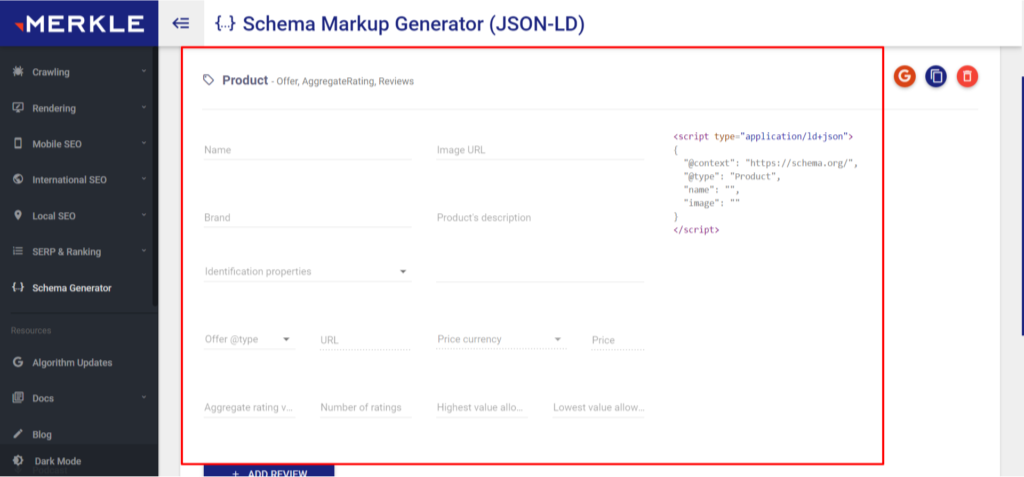
B. Review Schema
Review schema is a specific type of structured data markup that enables you to provide essential information about user reviews and ratings on your website. It helps search engines understand and display review-related data, such as average ratings, individual reviews, and product or service details, in search results. Implementing Review Schema can enhance the visibility and credibility of your online reviews, potentially attracting more users and improving click-through rates. It’s a valuable tool for ecommerce sites aiming to stand out and build trust among potential customers in search engine listings.
For review schema, you will requivre review name, author name, type of item etc.
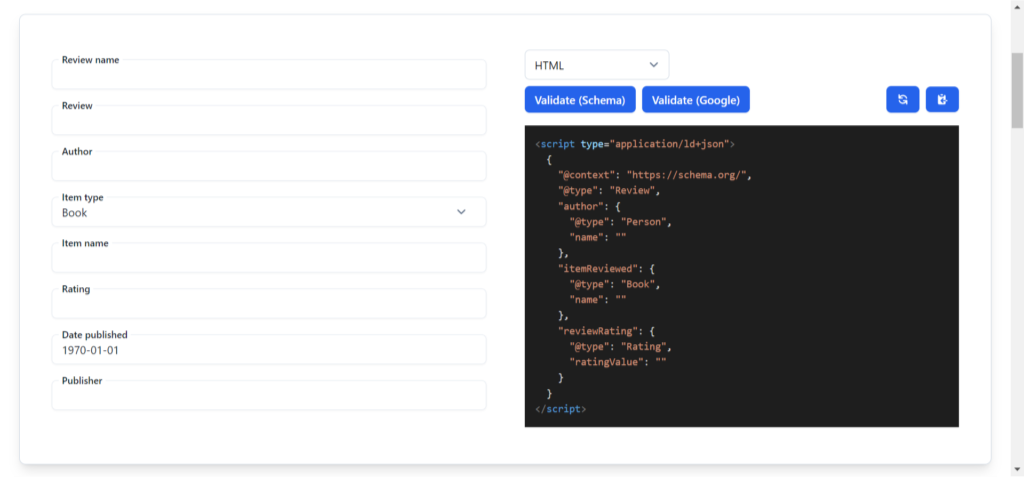

C. Item List Schema
Item list schema is a structured data markup used to organize and present a list of items or products in a structured format on a web page. It helps search engines understand the relationships between items, their attributes, and their order within a list. Implementing iItem list schema can enhance the visibility and organization of your content in search results, making it easier for users to find and navigate relevant information, particularly useful for ecommerce sites displaying product catalogs, services, or any form of list-based content.
Below is a snapshot of the item list schema; by filling in all the details, the item list schema will be generated.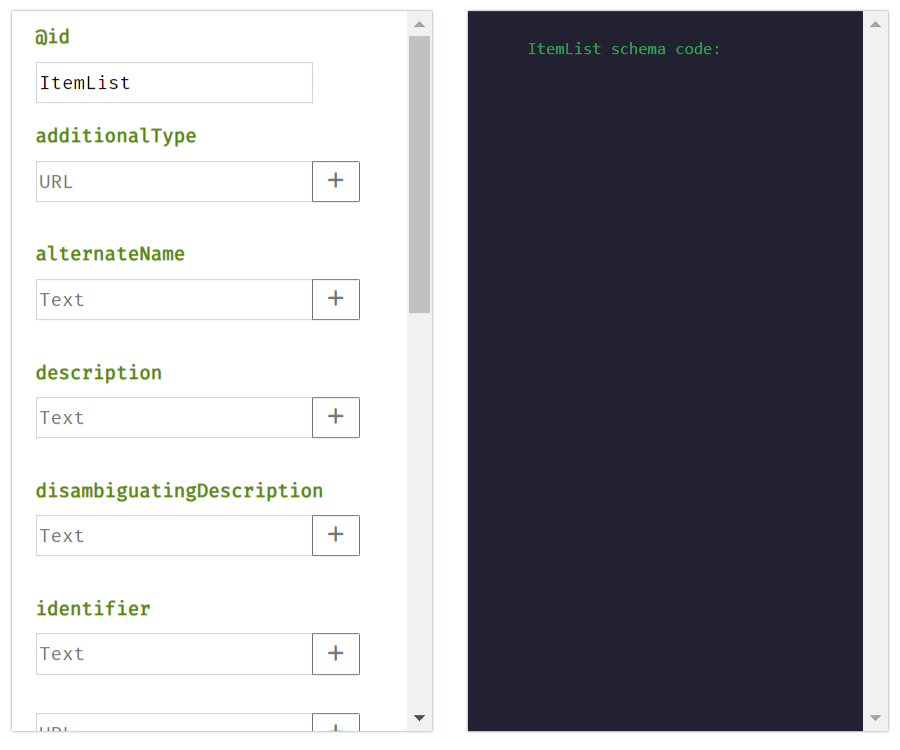
D. FAQs Schema
In FAQs schema, you have to put all the FAQs in the schema all the answer and questions. And then you can implement that schema into the code
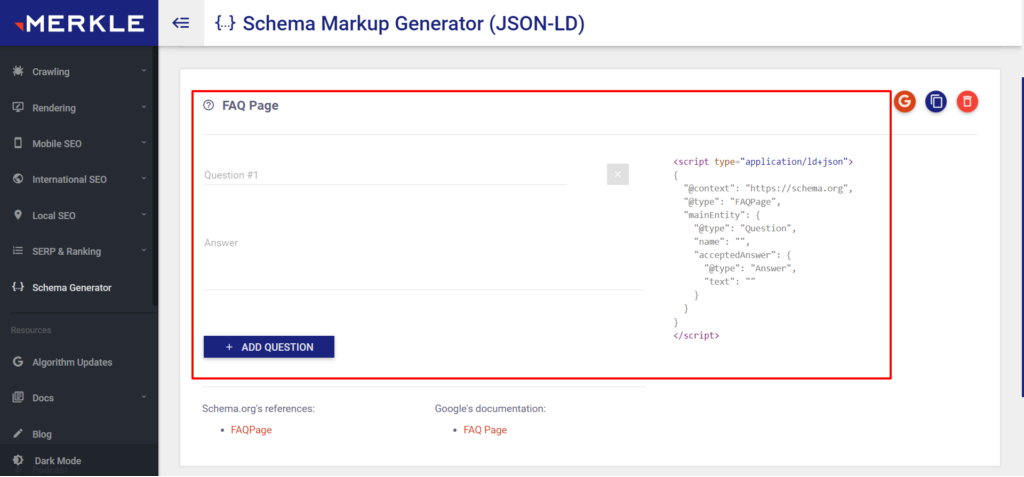
24. Conversion Rate Optimization (CRO)
Conversion Rate Optimization (CRO) is like fine-tuning your ecommerce store to transform curious visitors into paying customers. It’s a data-driven strategy aimed at improving the percentage of site visitors who take desired actions, such as making a purchase.
In ecommerce, CRO involves analyzing user behavior, testing design elements, and refining the shopping experience to boost conversions. This can include optimizing product pages, simplifying checkout processes, and enhancing calls to action.
By effectively implementing CRO tactics, you maximize the return on your website traffic investment. It’s not just about attracting visitors; it’s about ensuring they have a seamless and persuasive journey that results in sales. CRO is an essential aspect of ecommerce success, helping you grow your business and revenue while making the most of your existing traffic.
Plans
SEO Plans That Grow with Your E-Commerce Business
Lite
Boost your visibility and drive initial growth
- Complete SEO Audit
- 150 keywords & 50 pages optimized
- 15 content recommendations
- 100+ hours from SEO experts
- Customised reporting dashboards
Standard
Elevate your website to achieve higher visibility
- Complete SEO audit
- 240 keywords & 60 pages optimized
- 20 content recommendations
- 150+ hours from SEO experts
- Customised reporting dashboards
Pro
Supercharge your websites growth by advance strategies
- Complete SEO audit
- 320 keywords & 80 pages optimized
- 25 content recommendations
- 200+ hours from SEO experts
- Support for ecommerce tracking setup
- Customised reporting dashboards
Our clients talk about their transformative growth journeys.

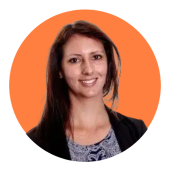
Carla Rabe

The Iconic


Achint Setia

Carla Rabe
Product Lead at Superbalist

The Iconic
Head of SEO at THE ICONIC

Achint Setia
VP Marketing at Myntra


Suresh Chettiar


Manish Dubey


Awant Bhagat

Suresh Chettiar
Marketing and Product Head at NUUU

Manish Dubey
CMO, ICICI Prudential Life Insurance Company Limited

Awant Bhagat
Head of Digital Marketing at Stader


Vipul Oberoi


Lara Salomon

Vipul Oberoi
Director - Marketing, CSR & Learning Solutions at D&B

Lara Salomon
Marketing Specialist at Solid Systems


Anurag Goyal

Anurag Goyal
Sr. Manager - Digital Marketing at Extramarks


Altaf Saiyed
Founder of Traya

Altaf Saiyed
Founder of Traya


Aparna Acharekar


Rituj Kate

Aparna Acharekar
Programming Head at Zee5

Rituj Kate
SM – Product at Dream11


Nidhi Gupta


Manan Bajoria

Nidhi Gupta
Marketing Assistant at Tata Consumer Products

Manan Bajoria
AVP | Growth, Ixigo
Other Solutions
More Ways to Drive Results
Search Engine Optimization
Unlock higher rankings, quality traffic, and increased conversions through tailored award-winning SEO strategies.
Conversion Rate Optimization
Enhance your website that drives users to complete a desired action to become your customer.
Website Development
Latest web development frameworks, responsive design techniques, and robust backend systems to ensure your website is fast, secure & seamless.
App Store Optimization
Optimise your mobile app with our award-winning ASO strategies that will lead to higher rankings & installs on Play Store & App Store.
Content Writing
Craft your brand narrative efficiently with our skilled writers, tailoring content strategies to effectively convey your story.
Local SEO
Boost local visibility, attract quality traffic, and drive conversions with tailored Local SEO strategies.
YouTube SEO
Drive video growth, attract loyal subscribers, and amplify engagement with tailored strategies.
Amazon SEO
Enhance your Amazon presence, capture more buyers, and drive sales with custom optimization strategies.
Link Building
Strengthen your site’s authority, attract quality traffic, and improve SEO with expert link building.
Summary
Ecommerce SEO: Driving Visibility and Sales
Ecommerce SEO is the process of optimizing online stores to improve their visibility on search engines, helping potential customers discover your products. Unlike traditional SEO, it focuses on driving organic traffic to product and category pages, enhancing the user experience, and boosting conversions. Key elements include keyword research, high-quality product descriptions, mobile optimization, and site speed improvements. By implementing effective ecommerce SEO strategies, businesses can attract the right audience, increase sales, and achieve long-term growth in the competitive online marketplace.
Additionally, ecommerce SEO builds brand credibility by ensuring your site ranks for relevant searches and provides valuable content. It enables businesses to reduce dependence on paid ads by driving sustainable organic traffic. A well-optimized ecommerce site not only increases visibility but also converts visitors into loyal customers.
Industries
Discover how we can help across various industries
Locations
We drive growth Worldwide, delivering solutions wherever you are
FAQs on Ecommerce SEO
What is Ecommerce SEO, and why is it important?
What are the best eCommerce SEO tools recommended for begineers?
What is the Difference between Ecommerce SEO and Traditional SEO?
Can Ecommerce SEO work for small online stores?
How useful was this post?
0 / 5. 0









